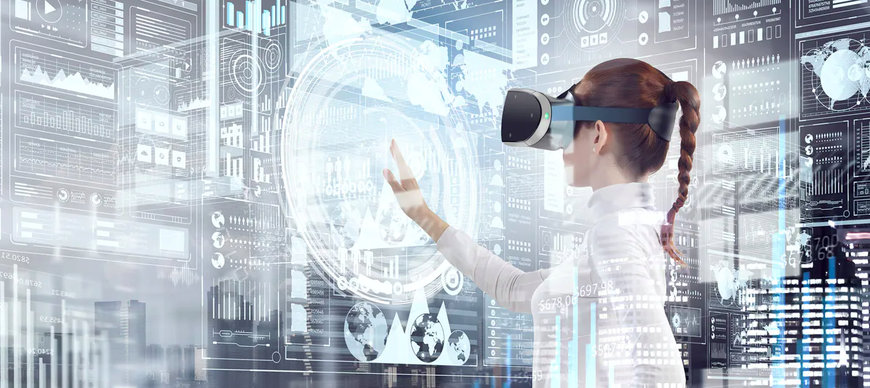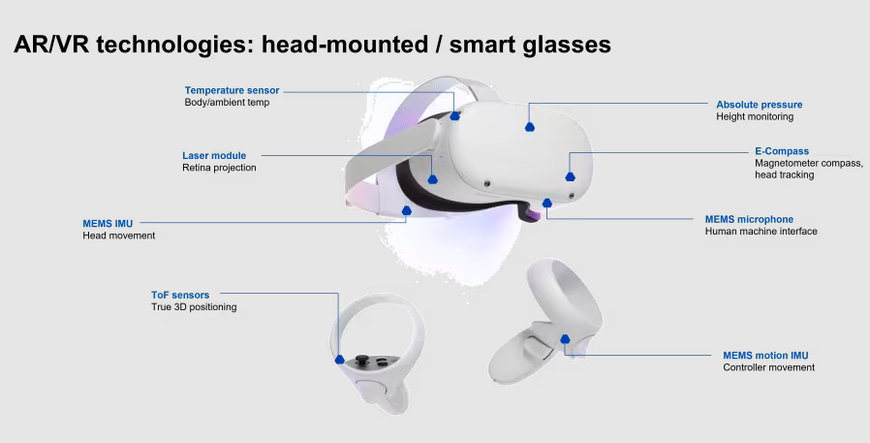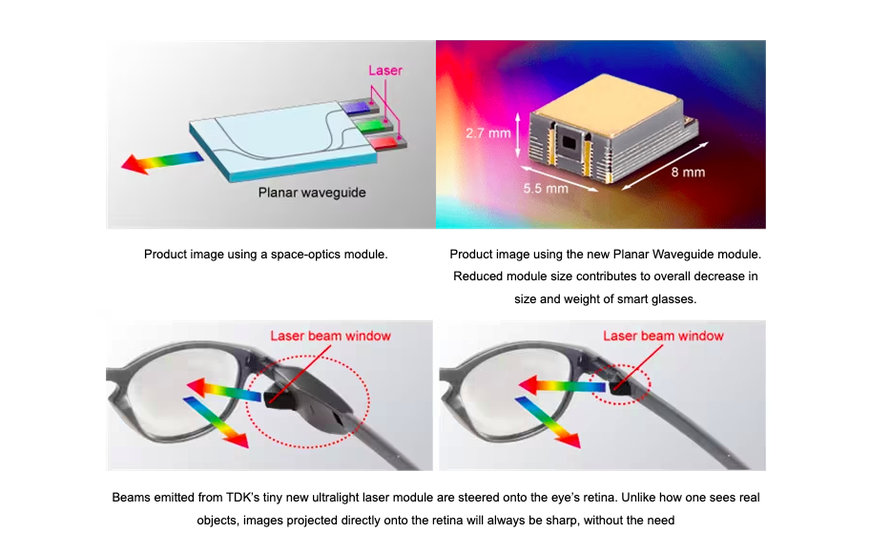www.usa-automation.net
11
'23
Written on Modified on
TDK News
TDK OFFERS A RICH SENSOR PORTFOLIO FOR THE METAVERSE
The technology that delivers the metaverse will build on the technology for virtual reality, using more sensors, and more different kinds of sensors. TDK has one of the richest sensor portfolios in the industry.

The expected rise of the metaverse and VR headsets
Even as virtual reality (VR) and augmented reality (AR) continue to grow and evolve, along comes an even more expansive concept: the metaverse. Where AR and VR are fundamentally visual in nature, we expect the metaverse to engage all our senses to make the blending of real and digital worlds an even richer experience.
Humans are visual creatures. VR and AR, fundamentally visual in nature, will be the foundational elements upon which the metaverse will be built.
Sensors are fundamental for virtual experiences
VR is defined in part by the use of goggles, AR by the use of eyeglasses and headsets. The Metaverse will be defined by wearables, though AR gear will certainly be an intrinsic part of the experience.
As much as VR and AR are fundamentally visual experiences, motion and positioning sensors are intrinsic enablers. These sensors are critical for many reasons, among them, monitoring where VR/AR/metaverse users are in real space to keep them safe; and tracking user movement to a) keep users safe in real space and b) translate their motions into the virtual world.
The sensors available for detecting the environment and fixing position include:
Even as virtual reality (VR) and augmented reality (AR) continue to grow and evolve, along comes an even more expansive concept: the metaverse. Where AR and VR are fundamentally visual in nature, we expect the metaverse to engage all our senses to make the blending of real and digital worlds an even richer experience.
Humans are visual creatures. VR and AR, fundamentally visual in nature, will be the foundational elements upon which the metaverse will be built.
Sensors are fundamental for virtual experiences
VR is defined in part by the use of goggles, AR by the use of eyeglasses and headsets. The Metaverse will be defined by wearables, though AR gear will certainly be an intrinsic part of the experience.
As much as VR and AR are fundamentally visual experiences, motion and positioning sensors are intrinsic enablers. These sensors are critical for many reasons, among them, monitoring where VR/AR/metaverse users are in real space to keep them safe; and tracking user movement to a) keep users safe in real space and b) translate their motions into the virtual world.
The sensors available for detecting the environment and fixing position include:
- Accelerometers for linear movement
- Tunnel magneto-resistance (TMR) magnetometers for high-performance directional sensing
- Ultrasonic sensors for time of flight (ToF) detection, useful for ranging and object detection
- MEMS microphones for voice interfacing
- Visual sensors for object detection and also for ToF
- Gyroscopes for rotational movement
- Pressure sensors to detect vertical positioning/height
- Lidar/radar for object detection and identification
- Body/ambient temperature sensors for sensing the environment
Sensors for the metaverse
The metaverse will engage all five senses eventually.
The metaverse will engage all five senses eventually.
- Sight: Cameras have long been included in AR systems for all the same reasons they are in our smartphones. They will continue to be used in metaverse applications.
- Sound: Voice recognition is already common with many IoT devices. Microphones are added to VR/AR/metaverse headsets and will be incorporated in wearables for all the same reasons.
- Touch: The data from many of the same sensors used for motion detection, positioning, and object detection can be fed into haptic devices. These might be anything from bracelets to gloves to partial- and full body suits. TDK is developing haptic technologies that can convey not only that something is being touched and how firmly, but what the texture of that object is.
- Smell and Taste: TDK currently is developing CO2 detectors that could provide warnings of potentially hazardous environmental conditions that most people could not detect on their own. Other sensors can be used to identify the presence – and sometimes even the quantity – of various chemical compounds. These sensors cannot be used to convey to users what a feast depicted in a video game might smell or taste like, but a selection of gas and chemical detectors might be able to tell us if a food item in the real world is unsafe to eat, or detect and identify a flower just by its fragrance.
The metaverse is apt to be modular and involves many different wearables that could be used in any combination depending on whatever metaverse apps each person chooses to use and how immersive they want their metaverse experiences to be.

A new display for AR & VR
Displays are fundamental to both VR and AR. VR encloses LED displays (of one type or another) inside goggles. There are different approaches to building AR rigs, but they generally involve either mounting a tiny digital display somewhere in the user’s field of view or projecting digital content onto the headset’s lenses. The Metaverse experience will depend on AR rigs, used in conjunction with wearable technology.
TDK recently introduced a new projection option. We have created a small, lightweight laser module that steers full-colour digital imagery straight to users’ retinas.
The new technology, which combines light emitted from laser elements through a planar path, can achieve a full-colour display of approximately 16.2 million colours within an ultra-small laser module.

A new display for AR & VR
Displays are fundamental to both VR and AR. VR encloses LED displays (of one type or another) inside goggles. There are different approaches to building AR rigs, but they generally involve either mounting a tiny digital display somewhere in the user’s field of view or projecting digital content onto the headset’s lenses. The Metaverse experience will depend on AR rigs, used in conjunction with wearable technology.
TDK recently introduced a new projection option. We have created a small, lightweight laser module that steers full-colour digital imagery straight to users’ retinas.
The new technology, which combines light emitted from laser elements through a planar path, can achieve a full-colour display of approximately 16.2 million colours within an ultra-small laser module.

Sensor fusion and enabling software
Data from these different sensors must be processed and software that can integrate that data to produce progressively richer, more enjoyable, and safe experiences must be continuously refined.
One example of this kind of software enrichment applies to ultrasonic sensors. TDK SmartSonic technology adds intelligence to TDK’s ToF sensors through an integrated ultra-low-power SoC, providing system developers with pre-processed data such as nearby target distance, presence detection, and more.
Data from different sensors can be compared to arrive at conclusions. If a VR system’s pressure sensor detects that the user’s headset remains at the same height while the 6DoF sensor detects the headset is tilting from 0 degrees to 45 degrees, the system can compare height data against tilt data and surmise the user is looking up but is not standing up, sitting down, or crouching.
Sensor fusion is far more complex and experience is a huge advantage. TDK has provided suites of sensors to the automotive and industrial automation markets, helped pioneer sensor fusion, and is bringing that expertise to bear on the VR/AR/metaverse market with their sensors, embedded processors, and software development skills.
Data from these different sensors must be processed and software that can integrate that data to produce progressively richer, more enjoyable, and safe experiences must be continuously refined.
One example of this kind of software enrichment applies to ultrasonic sensors. TDK SmartSonic technology adds intelligence to TDK’s ToF sensors through an integrated ultra-low-power SoC, providing system developers with pre-processed data such as nearby target distance, presence detection, and more.
Data from different sensors can be compared to arrive at conclusions. If a VR system’s pressure sensor detects that the user’s headset remains at the same height while the 6DoF sensor detects the headset is tilting from 0 degrees to 45 degrees, the system can compare height data against tilt data and surmise the user is looking up but is not standing up, sitting down, or crouching.
Sensor fusion is far more complex and experience is a huge advantage. TDK has provided suites of sensors to the automotive and industrial automation markets, helped pioneer sensor fusion, and is bringing that expertise to bear on the VR/AR/metaverse market with their sensors, embedded processors, and software development skills.

